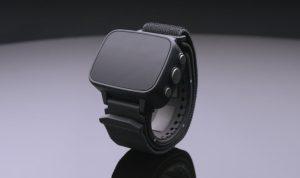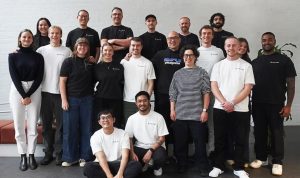
MobiHealthNews’ Rising Applied sciences Collection will highlight organizations creating, scaling and investing in progressive healthcare applied sciences. What follows is an element one among an eight-part sequence:
Precision Neuroscience is creating a brain-computer interface (BCI) to assist sufferers with neurological circumstances – corresponding to stroke, ALS and spinal wire harm – management computer systems and sensible gadgets utilizing solely their ideas.
Jayme Strauss, chief business and scientific officer at Precision Neuroscience, sat down with MobiHealthNews to debate the corporate’s minimally invasive BCI, the Layer 7 Cortical Interface, which rests on the mind’s floor with out penetrating tissue.
MobiHealthNews: Are you able to inform our readers about Precision Neuroscience?
Jayme Strauss: Our mission is de facto to enhance the lives of the hundreds of thousands of individuals which can be fighting neurological circumstances and accidents, actually give them autonomy and independence again into their life and be capable to make connections with their household and family members round them and inside the world.
I feel there’s this means that BCI offers folks hope – hope for one thing that they have not had earlier than – the place they will join again into the world, combine again into the world, play video video games with their family members, talk, ask for assist, return to work, all of these items that, till BCIs, have been not possible for them to do. So, that is actually our mission, and what we’re centered on.
MHN: Precision’s expertise contains the Layer 7 Cortical Interface. How does it truly work?
Strauss: The Layer 7 Cortical Interface is an array. So, it is a skinny movie microelectrode array. It’s a couple of fifth the thickness of a human hair, and it actually conforms to the floor of the mind.
When you consider a mind, it is like mountains and valleys, proper? We now have all these sulci and complex networks into these deep sulci the place there’s rather a lot occurring within the mind.
The entire different electrode arrays which have been utilized in BCI earlier than have been penetrating, which implies there’s microneedles or threads or various things that must penetrate deeper into the mind to gather the necessary neural information that’s wanted to have the ability to decode after which provide the intent by means of an enabling of a tool.
Precision’s is completely different. It’s skinny movie, flat, so it doesn’t penetrate mind tissue. You’ll be able to transfer it round. Precision is necessary in these sufferers when you find yourself serious about the place you will put the gadget and the millimeters truly matter. However should you’re already penetrating, or you’re a stent electrode, as soon as you’re in there, you can’t pull it out and transfer it some other place. You are there.
So, this permits us some flexibility to ensure that we’re attending to the proper a part of the mind, particularly over the motor cortex. And it is also detachable and reversible. Different gadgets which can be within the technique of attending to market should not detachable. I imply, you can take away them, however you can not substitute them as a result of that cortex is then broken from what was in place.
So, you’ve got the electrode array, after which for the everlasting implant, what it will likely be, it’s referred to as an SGI, a subgaleal. It sits between the bone of the cranium and the scalp. So, beneath. It’s skinny and flat. That basically homes numerous the electronics and among the decoding. So, the information that we get from the 1,024 channels on the mind transmits to this SGI after which is processed down by means of a lead that goes behind the ear, down into the chest wall, and that’s the place the battery and transmitter is. That then permits the information to transmit out to interface with the computer systems or the cellular gadget or regardless of the assistive expertise that we’re amassing to.
As a result of we’re sitting immediately on the cortical floor of the mind, the decision that we get of the information and the bandwidth of the information is far bigger than some other that’s at the moment on the market.
So, the predicate that we had for the FDA 510(okay) are very previous tech electrodes. There have been solely 4 electrodes in comparison with our 1,024, and what you are capable of see by means of our visualization software program is definitely seeing the mind sync in actual time.
We have already implanted in 39 sufferers throughout some fairly huge facilities, and each time that we go in and the surgeon sees it for the primary time, they’re like, “I am truly, for the primary time ever, seeing the mind suppose in actual time.”
So, we’re capable of gather that neural information in actual time in excessive decision, and what we have been capable of show and present in these sufferers that we have already implanted is we are able to take about 3 minutes’ value of knowledge and decode it and prepare a mannequin, after which we run experimental job paradigms of gesture actions or speech, and we’re capable of predict, with pretty good accuracy, within the upward of 90%, the intent. So, my intent to maneuver my hand, my intent to manage a joystick, my intent to talk a phrase, and we’re capable of decode that in actual time.
MHN: Does it truly permit somebody to try this?
Strauss: It’ll. So, with the absolutely implantable system, that’s what it’ll do. So the 510(okay) is only for the electrode array element, which is the useful element of our system. It is the very best danger. It is the one touching the mind tissue. It is the one which the FDA is de facto fearful about ensuring that we meet all of these requirements.
Then there are the opposite elements of the system that should undergo the regulatory approval course of as a completely implantable system, however that’s the precise intent.
The intent is we are going to really be capable to permit people, in real-time, to manage a pc. You realize, create a PowerPoint presentation, reply emails, management their house surroundings with sensible expertise. Work together simply by means of their ideas alone.
MHN: The 39 sufferers which have been implanted, what are they capable of do now?
Strauss: So these sufferers we did forward of the 510(okay). Nicely, we have now achieved a pair after the 510(okay), however what these research are – we name them investigator-initiated research – they’re pushed by the investigator on the web site that’s desirous to reply a scientific query, however due to the protection profile of our gadget, we have now been capable of go in the place a affected person is already having a neurosurgical process, corresponding to a craniotomy, the place they’re eradicating a mind tumor or deep mind stimulation, the place they’re implanting the microelectrodes to do stimulation for a affected person with Parkinson’s illness, and we have been capable of put our gadget on the mind for minutes up to some hours and gather neural information and do these duties and paradigms.
Now, with the 510(okay), what it permits us to do is develop that even additional. So, now we are able to depart the gadget on the mind. When a affected person goes to a neuro ICU, or what we name a monitor unit, we’re capable of gather extra information, work with the affected person, perceive how their mind works, perceive their neural community, how their mind is functioning and dealing and, post-procedure or throughout, what is occurring within the mind. That permits us to maintain it within the affected person for as much as 30 days.
So, it permits us to develop our analysis and growth and have a look at completely different affected person populations and for longer durations of time. After which it additionally permits us to have the ability to commercialize it. We will now promote this gadget by means of the marketplace for mapping, recording, stimulating throughout these procedures and as much as 30 days.
MHN: Precision Neuroscience’s direct competitor is Elon Musk’s mind implant firm Neuralink. What’s the distinction between the 2 corporations’ BCIs?
Strauss: It’s that security profile that we talked about. So, Neuralink does penetrate the mind. There are threads, and it needs to be implanted with a robotic as a result of the way in which that they designed the gadget, there’s the hub and it implants, after which there are these threads, and the threads are so skinny {that a} surgeon couldn’t manipulate them. So, it needs to be implanted with a robotic gadget. The surgeon is within the room, however they must implant it with the robotic.
Ours doesn’t penetrate wholesome mind tissue. So, it simply sits on the floor, the twin floor of the mind, the cortex. So it permits us extra flexibility with the place we are able to place the gadget, how we place the gadget, and having the ability to take away it. Ours is taken into account minimally invasive as a result of you aren’t having to do a giant craniotomy. We will implant our gadget by means of a small burr gap.
Additionally, we have now developed a expertise that we’ll be utilizing after we do the absolutely implantable gadget; it’s referred to as a microcranial slit, and it’s patented. If you consider previous doorways, the place you’ll have the mail slot and they’d slide the letter by means of, that’s what that is. So, it’s actually a slit that occurs on the floor and thru the cranium, after which we take the gadget and we slide it down onto the dural floor of the mind.
MHN: What does Precision in the end see occurring with this expertise?
Strauss: We would like to take it to as many sufferers, households and people that want this. We’re a very clinically centered firm. We’re based by a neurosurgeon, Dr. Ben Rapoport. He’s a practising neurosurgeon at Mount Sinai. He actually believes within the minimally invasive security profile, and that is why the design is what it’s.
However we’re actually centered on scientific functions. So, serving to folks with ALS, spinal wire harm and stroke to have the ability to combine and join again into the world in a method that they haven’t been capable of. To have the ability to have some independence and autonomy again. And that is actually our focus proper now within the quick time period.













